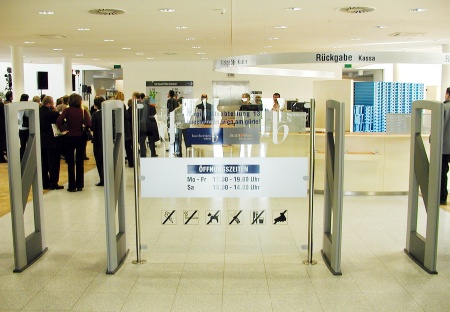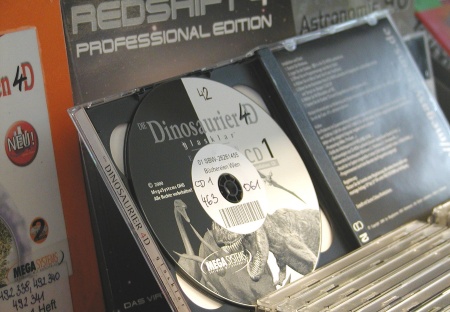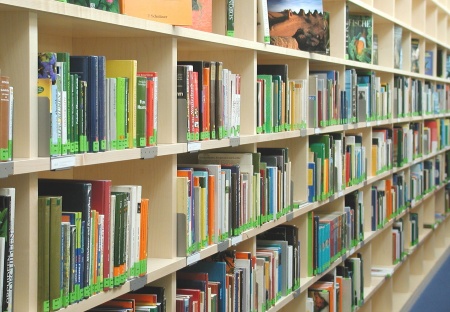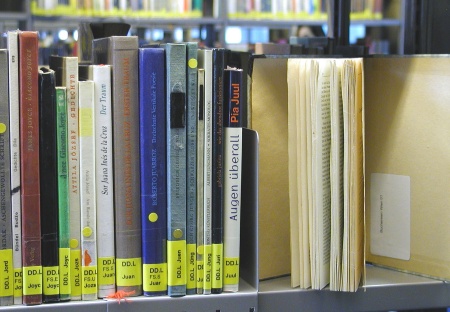Infineon for Bookworms: Complete Solution with 300,000 Radio Chips Creates New Reading Experience in Vienna`s Main Library
San Jose, Calif. - April 7, 2003 In the context of its Agenda 5-to-1 strategy that is designed to position the company as the leading semiconductor solution provider within five years, Infineon Technologies (FSE/NYSE: IFX) has developed a user-friendly self-service system for the users of Viennas new multimedia main library. 240,000 books as well as 60,000 CDs and DVDs from the inventory of Viennas new main library have been equipped with radio chips for data transmission. Use of the new RFID (Radio Frequency Identification) chips in the new library building permits users to check out books, CDs or DVDs themselves, without waiting in line at a counter for service by a librarian.
Infineon implemented the project together with its partner ekz, a library equipment supplier based in Reutlingen (Germany), and Swiss partner Bibliotheca Library Systems AG, a worldwide systems integrator that has specialized in libraries. Bibliotheca markets the library system worldwide. In addition to Vienna, Bibliotheca and Infineon have already equipped libraries in Switzerland, Belgium, and Germany. In Germany, more libraries in Stuttgart, Kronberg, Bonn, Bad Homburg, and Mittweida will follow as early as this year. With these projects, Infineon and Bibliotheca will further strengthen their market leadership in the field of RFID library systems in Europe.
At the Vienna main library, the radio chips store information such as copy number, author, library code, location in the library, systematic group, last individual who checked out the book, status (checked out or not) as well as completeness information for media packages (multi-volume books or multiple CDs). The overall system used by Viennas main library also includes 13 read and write units for the management of the checked out and returned media. Advantages of the RFID technology: Multiple books are covered at the same time during the check-out and check-in operations. Up to now, it was required to read out each label on the inside cover of a book. This procedure must be completed for about 3,500 visitors every day in comparable libraries in large cities. The system used in Vienna was implemented with a major contribution of the Infineon design center in Graz.
Time savings are also achieved when newly acquired media are entered into the inventory. Instead of using two information carriers, i.e. the barcode for accounting and the electromagnetic safety strip for theft protection, it is now only required to write data into the radio chip. This cuts the manual effort per operation in half. The technology working in the background handles the routine check-out and management operations for the media, while the library attendants have more time for their main task, which is providing advice to readers. Additional benefits of the migration to RFID: RFID chips have individual identifications and can store far more information about an item than it is possible to store with barcodes. In addition, RFID chips are rewritable, which permits data to be replaced or updated automatically. This works even with the chip not being visible. The RFID chips from Infineon also provide security functions and can prevent the theft of valuable books. This security feature can be implemented in a similar manner to retail store theft prevention, with a barrier that generates an audible signal in case of the contactless detection of the RFID chip in the book.
The first step to implement the self-service library has already been taken in Vienna: To check out books, customers place the selected items on the workstation and insert their library pass into the slot of the reader, which is much like using an ATM. Over a radio link with the system that is integrated in the table, the contents of the RFID chips are scanned, and the check-out is registered. In addition, readers can use the terminal to verify the status of their accounts and check if they need to return another book. Starting in late 2003, such self-service terminals will also permit the proper return of books to the library. The introduction of this kind of self-service system could especially make the return of borrowed books independent of the official opening hours.
240,000 books as well as 60,000 CDs and DVDs from the inventory of Viennas new main library were equipped with RFID (Radio Frequency Identification) chips for data communication. Seven read and write units used to embed the RFID chips into the books and to store the information on the chips were installed. Another six read and write units are available to the attendants to register the checked-out media. In addition, four self-service terminals, the so-called EasyChecks, are available to the users.
RFID technology is a cost-effective solution whenever thousands of objects must be identified and managed quickly and reliably or their position tracked. Infineons my-d chip can also be embedded in ID passes, admission tickets and goods as well as packages of all kind. It has up to 10 kilobytes of available memory, which corresponds to about two A4 pages of plain text. The memory itself can be partitioned into multiple sectors for different users, with read and write access being granted only to authorized individuals. Special encryption techniques prevent unauthorized access to the secured data.
For the library application, Infineons my-d chip is used as the basis to design an entire system that meets the requirements of the RFID application in libraries. The decisive factor with this kind of application is the integration of data communications to and from the RFID labels and the integration of the database. Besides the selection of the proper hardware components, it is especially the created software that supports the success of the overall system.
For the use in libraries, the my-d chip is implemented as an RFID label and comprises four parts: chip and antenna that together form the so-called inlay, as well as the top and base material of the labels, which is paper or plastic in most cases. The label has a size of about 8 x 5 cm and is applied to the book next to the barcode. For the application to CDs and DVDs, a special CD label was developed that has a diameter of 30 mm and is directly applied to the image or sound medium.
Technical information about Infineons my-d chips are available at: www.infineon.com/ident
Infineon implemented the project together with its partner ekz, a library equipment supplier based in Reutlingen (Germany), and Swiss partner Bibliotheca Library Systems AG, a worldwide systems integrator that has specialized in libraries. Bibliotheca markets the library system worldwide. In addition to Vienna, Bibliotheca and Infineon have already equipped libraries in Switzerland, Belgium, and Germany. In Germany, more libraries in Stuttgart, Kronberg, Bonn, Bad Homburg, and Mittweida will follow as early as this year. With these projects, Infineon and Bibliotheca will further strengthen their market leadership in the field of RFID library systems in Europe.
At the Vienna main library, the radio chips store information such as copy number, author, library code, location in the library, systematic group, last individual who checked out the book, status (checked out or not) as well as completeness information for media packages (multi-volume books or multiple CDs). The overall system used by Viennas main library also includes 13 read and write units for the management of the checked out and returned media. Advantages of the RFID technology: Multiple books are covered at the same time during the check-out and check-in operations. Up to now, it was required to read out each label on the inside cover of a book. This procedure must be completed for about 3,500 visitors every day in comparable libraries in large cities. The system used in Vienna was implemented with a major contribution of the Infineon design center in Graz.
Time savings are also achieved when newly acquired media are entered into the inventory. Instead of using two information carriers, i.e. the barcode for accounting and the electromagnetic safety strip for theft protection, it is now only required to write data into the radio chip. This cuts the manual effort per operation in half. The technology working in the background handles the routine check-out and management operations for the media, while the library attendants have more time for their main task, which is providing advice to readers. Additional benefits of the migration to RFID: RFID chips have individual identifications and can store far more information about an item than it is possible to store with barcodes. In addition, RFID chips are rewritable, which permits data to be replaced or updated automatically. This works even with the chip not being visible. The RFID chips from Infineon also provide security functions and can prevent the theft of valuable books. This security feature can be implemented in a similar manner to retail store theft prevention, with a barrier that generates an audible signal in case of the contactless detection of the RFID chip in the book.
The user-friendly self-service library of the future
The first step to implement the self-service library has already been taken in Vienna: To check out books, customers place the selected items on the workstation and insert their library pass into the slot of the reader, which is much like using an ATM. Over a radio link with the system that is integrated in the table, the contents of the RFID chips are scanned, and the check-out is registered. In addition, readers can use the terminal to verify the status of their accounts and check if they need to return another book. Starting in late 2003, such self-service terminals will also permit the proper return of books to the library. The introduction of this kind of self-service system could especially make the return of borrowed books independent of the official opening hours.
The overall RFID system of Viennas main library at a glance
240,000 books as well as 60,000 CDs and DVDs from the inventory of Viennas new main library were equipped with RFID (Radio Frequency Identification) chips for data communication. Seven read and write units used to embed the RFID chips into the books and to store the information on the chips were installed. Another six read and write units are available to the attendants to register the checked-out media. In addition, four self-service terminals, the so-called EasyChecks, are available to the users.
Background information about Infineons library system
RFID technology is a cost-effective solution whenever thousands of objects must be identified and managed quickly and reliably or their position tracked. Infineons my-d chip can also be embedded in ID passes, admission tickets and goods as well as packages of all kind. It has up to 10 kilobytes of available memory, which corresponds to about two A4 pages of plain text. The memory itself can be partitioned into multiple sectors for different users, with read and write access being granted only to authorized individuals. Special encryption techniques prevent unauthorized access to the secured data.
For the library application, Infineons my-d chip is used as the basis to design an entire system that meets the requirements of the RFID application in libraries. The decisive factor with this kind of application is the integration of data communications to and from the RFID labels and the integration of the database. Besides the selection of the proper hardware components, it is especially the created software that supports the success of the overall system.
For the use in libraries, the my-d chip is implemented as an RFID label and comprises four parts: chip and antenna that together form the so-called inlay, as well as the top and base material of the labels, which is paper or plastic in most cases. The label has a size of about 8 x 5 cm and is applied to the book next to the barcode. For the application to CDs and DVDs, a special CD label was developed that has a diameter of 30 mm and is directly applied to the image or sound medium.
Technical information about Infineons my-d chips are available at: www.infineon.com/ident
About Infineon
Infineon Technologies AG, Munich, Germany, offers semiconductor and system solutions for the automotive and industrial sectors, for applications in the wired communications markets, secure mobile solutions as well as memory products. With a global presence, Infineon operates in the US from San Jose, CA, in the Asia-Pacific region from Singapore and in Japan from Tokyo. In the fiscal year 2002 (ending September 2002), the company achieved sales of Euro 5.21 billion with about 30,400 employees worldwide. Infineon is listed on the DAX index of the Frankfurt Stock Exchange and on the New York Stock Exchange (ticker symbol: IFX). Further information is available at www.infineon.com.
Infineon Technologies Austria AG with headquarters in Villach and research and development centers in Villach, Graz, Linz, and Vienna, generated overall revenues of 515 million euros (including DICE and Comneon) in its fiscal year 2002 (to September 30) and employs about 2,500 people in Austria. Infineon Technologies Austria AG is a company of Infineon Technologies AG.
About Bibliotheca
Bibliotheca RFID Library Systems AG is a Swiss company that provides a software and hardware system for the theft protection, self-service accounting and inventory as well as the return of media based on the RFID technology. Particular capabilities are the long-term experience in object protection and the suitability of the labels for all media (including CDs). Bibliotheca has references in 14 public and scientific libraries, which makes the company the market leader in Europe. The system was designed in close cooperation with librarians and Infineon.
Information Number
INFSMS200304.062
Press Photos
-
 Infineon for Bookworms: Complete Solution with 300,000 Radio Chips Creates New Reading Experience in Vienna`s Main LibraryPress Photo
Infineon for Bookworms: Complete Solution with 300,000 Radio Chips Creates New Reading Experience in Vienna`s Main LibraryPress PhotoJPG | 264 kb | 1535 x 1063 px
Press PhotoJPG | 12 kb | 160 x 111 px
-
 Infineon for Bookworms: Complete Solution with 300,000 Radio Chips Creates New Reading Experience in Vienna`s Main LibraryPress Photo
Infineon for Bookworms: Complete Solution with 300,000 Radio Chips Creates New Reading Experience in Vienna`s Main LibraryPress PhotoJPG | 251 kb | 1535 x 1063 px
Press PhotoJPG | 13 kb | 160 x 111 px
-
 Infineon for Bookworms: Complete Solution with 300,000 Radio Chips Creates New Reading Experience in Vienna`s Main LibraryPress Photo
Infineon for Bookworms: Complete Solution with 300,000 Radio Chips Creates New Reading Experience in Vienna`s Main LibraryPress PhotoJPG | 300 kb | 1535 x 1063 px
Press PhotoJPG | 17 kb | 160 x 111 px
-
 Infineon for Bookworms: Complete Solution with 300,000 Radio Chips Creates New Reading Experience in Vienna`s Main LibraryPress Photo
Infineon for Bookworms: Complete Solution with 300,000 Radio Chips Creates New Reading Experience in Vienna`s Main LibraryPress PhotoJPG | 295 kb | 1535 x 1063 px
Press PhotoJPG | 13 kb | 160 x 111 px
